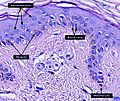Melanin facts for kids
Melanin is a natural color, or pigment, found in your skin, hair, and eyes. It's like a built-in sunscreen that helps protect your body from the sun's harmful rays. Melanin gives your skin its unique color, and it's made deep inside the outer layer of your skin, called the epidermis. It's created from a special building block called amino acid tyrosine.
Contents
What is Melanin?
Melanin is a special substance that gives color to living things. Think of it as a natural dye. It's found in many parts of your body, including your skin, hair, and the colored part of your eyes (the iris). This pigment is super important because it does more than just give you color.
How Melanin Protects You
One of melanin's most important jobs is to protect you from the sun. When you spend time outdoors, the sun sends out radiation. Too much of this can be bad for your skin. Melanin acts like a shield, absorbing the sun's harmful ultraviolet (UV) rays. This helps prevent sunburn and can lower the risk of skin damage over time.
What Gives Skin Its Color?
The amount and type of melanin you have determines your skin, hair, and eye color. People with more melanin tend to have darker skin, hair, and eyes. Those with less melanin have lighter colors. This is why people from different parts of the world have such a wide range of beautiful skin tones.
Where is Melanin Made?
Melanin is made in special cells called melanocytes. These cells are found deep in the epidermis, which is the top layer of your skin. Melanocytes produce melanin when they get a signal, often from sunlight. The melanin then moves into other skin cells, giving them color and protection.
Types of Melanin
There are a few different types of melanin:
- Eumelanin: This type of melanin gives skin and hair brown and black colors. If you have a lot of eumelanin, your skin will be darker and tan easily.
- Pheomelanin: This type gives red and yellow colors. People with red hair and freckles often have more pheomelanin.
- Neuromelanin: This type is found in the brain. Scientists are still learning about its exact role.
Conditions Related to Melanin
Sometimes, the body doesn't produce melanin in the usual way.
- Albinism: This is a condition where a person's body produces very little or no melanin. People with albinism often have very pale skin, white hair, and light-colored eyes. Their skin is very sensitive to the sun, so they need extra protection.
- Vitiligo: This condition causes patches of skin to lose their color. This happens when the melanocyte cells in those areas stop working or die.
Related pages
Images for kids
-
Micrograph of Melanin pigment (light refracting granular material—center of image) in a pigmented melanoma.
-
Albinism occurs when melanocytes produce little melanin. This albino girl is from Papua New Guinea.
See also
 In Spanish: Melanina para niños
In Spanish: Melanina para niños




